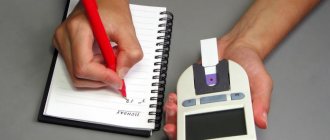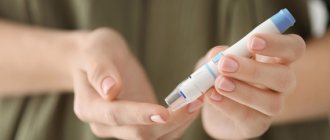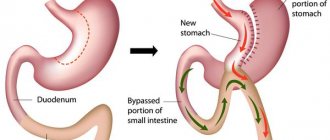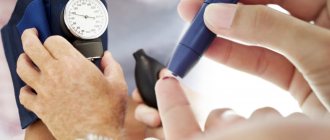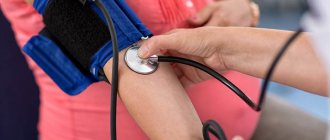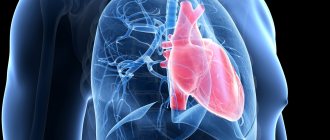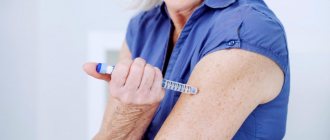Irkutsk City Clinical Hospital No. 9
Memo for the patient:
What to do to prevent the development of hyperglycemia and diabetes.
Facts about hyperglycemia and diabetes:
- There is a new case of diabetes every 20 minutes in the United States, and every forty minutes in Europe.
- Currently, the prevalence of overt diabetes mellitus among the population of economically developed countries reaches 4-7%. However, mass surveys have shown that there are twice as many patients with latent forms of diabetes.
- In individuals whose body weight exceeds the norm by 20%, diabetes mellitus is detected 10 times more often than in the population. Among people with severe obesity, the incidence of diabetes increases 30 times. The combination of several risk factors has been shown to increase the likelihood of developing clinical diabetes mellitus by approximately 29 times.
- The mortality rate among patients with diabetes mellitus who have suffered a myocardial infarction is 1.5 - 2.5 times higher than in persons without carbohydrate metabolism disorders.
Hyperglycemia (high blood sugar) occurs when blood sugar levels rise above normal. This occurs when the pancreas does not produce enough insulin or it does not work as well as it should. Then glucose, the main source of energy, is not absorbed by the cells, the cells begin to “starve”, and weakness develops; blood sugar, on the contrary, rises and draws water from the cells - thirst appears; Due to metabolic disorders, small and large vessels of the brain, heart, kidneys and other organs are quickly affected, and immunity is impaired.
Check if you have any signs of diabetes?
- strong thirst;
- drowsiness;
- blurred vision;
- frequent urination;
- irritability;
- itching (especially in the perineal area);
- dry skin, pustules and boils;
- increased appetite;
- sticky urine.
If blood glucose levels are too high, diabetes develops. In 95% of cases, this is type 2 diabetes, which occurs more often in people over 40 years of age who lead an unhealthy lifestyle. Look, maybe you also have risk factors for this dangerous disease?
- age over 45 years;
- diabetes mellitus in relatives;
- excess body weight;
- low physical activity;
- accidentally detected elevated glucose levels during examination;
- increased blood sugar during pregnancy and the birth of a large fetus;
- high blood pressure, above 140/90 mmHg;
- changes in cholesterol metabolism (low high-density lipoprotein levels ≤ 0.9 mmol/l and/or triglyceride levels ≥ 2.82 mmol/l);
- polycystic ovary syndrome;
- suffered strokes, heart attacks.
If something has alerted you, then the only way to check whether you have diabetes or not is to do a blood test: determine your glucose level on an empty stomach and/or 2 hours after taking 75 grams of glucose. The frequency of examination depends on the risk group you fall into.
| Risk group | Frequency of examination |
| Persons over 45 years of age | At least once every 3 years; |
| Combination of 3 or more risk factors | At least once every 3 years; |
| Persons with prediabetes, especially those who are overweight | Once every 1-2 years |
Capillary blood glucose level
| Carrying out analysis | Norm | Prediabetes | Diabetes |
| On an empty stomach | 3,3-5,5mmol/l | 5,5-6,1mmol/l | > 6,1mmol/l |
| 2 hours after taking 75 grams of sugar or any time of the day | < 7,8mmol/l | 7,8-11,1mmol/l | >11,1mmol/l |
You can also check your risk of developing prediabetes or type 2 diabetes in the next 10 years using the following questionnaire:
- Age: up to 45 years (0 points), 45-54 years (2 points), 55-64 years (3 points), over 65 years (4 points).
- Body mass index - height (m) divided by body weight (kg) squared, for example, with a height of 165 cm and a weight of 73 kg, the index is 73: (1.65 m X 1.65) = 26.8 = 27 kg /m2: below 25 kg/m2 (0 points), 25-30 kg/m2 (1 point), more than 30 kg/m2 (3 points).
- Waist circumference - measured under the ribs at the level of the navel. Men: less than 94 cm (0 points), 94-102 cm (3 points), more than 102 cm (4 points). Women: less than 80 cm (0 points), 80-88 cm (3 points), more than 88 cm (4 points).
- How often do you eat vegetables, fruits or berries? Every day (0 points), not every day (1 point);
- Do you exercise regularly? Do you exercise 30 minutes every day or 3 hours during the week? Yes (0 points), no (2 points);
- Have you ever taken medications regularly to lower your blood pressure? No (0 points), yes (2 points).
- Have you ever had your blood sugar level higher than normal (during preventive examinations, during illness or pregnancy)? No (0 points), yes (5 points).
- Did your relatives have type 1 or type 2 diabetes? No (0 points), yes: grandparent, aunt/uncle, cousins (3 points), parents, brother/sister or own child (5 points).
TOTAL POINTS__________________________
Your risk of developing type 2 diabetes over 10 years is:
| Total points | DM risk level 2 | Probability of developing type 2 diabetes |
| Less than 7 | Low risk | 1 in 100 (1%) |
| 7-11 | Slightly elevated | 1 in 25 (4%) |
| 12-14 | Moderate | 1 out of 6 (17%) |
| 15-20 | High risk | 1 out of 3 (33%) |
| more than 20 | Very high risk | 1 out of 2 (50%) |
- If you score less than 12 points, you are in good health and should maintain a healthy lifestyle.
- If you score 12-14 points, you may have prediabetes. You should ask your doctor about lifestyle changes.
- If you score 15-20 points, you may have prediabetes or type 2 diabetes. It is advisable for you to check your blood sugar levels. You may need to change your lifestyle and may need medication to control your blood sugar levels.
- If you score more than 20, you most likely have type 2 diabetes. You should regularly check your blood sugar levels with a glucometer. You need to change your lifestyle and need medications to control your blood sugar levels.
Diabetes prevention should start in the kitchen.
About 80% of patients with type 2 diabetes are overweight, which weakens the effect of insulin. Therefore, the primary task in this situation is to reduce weight (not to the full norm, but 5-10% below the original) and maintain it at this level through continued dieting. This diet should be tasty, varied, not cause a feeling of hunger, but contain fewer calories than the patient consumed before; for this you just need to follow some rules:
These products should be sharply limited:
a) Severely increases blood sugar:
- Sugar, honey, dried fruits, fruit juices, confectionery, sweets, jam, lemonades (“Fanta”, “Pepsi”, etc.), natural kvass.
- Semolina porridge, mashed potatoes, heavily boiled porridge.
b) Contain a lot of calories:
- Butter, vegetable oil (especially in salads, vinaigrettes and when heating food), sour cream, mayonnaise, butter substitutes (Rama, etc.).
- Lard, sausages and sausages, sausages and pates, smoked meats, fatty meat, fatty fish, meat by-products (liver, liver), chicken legs, poultry skin.
- Fatty (“yellow” and processed) cheeses, cream, fatty cottage cheese.
- Nuts and seeds, pies and pies.
The consumption of these products should be halved:
- Bread (black or white), cereals (rice, buckwheat, oatmeal, etc.).
- Potatoes, pasta, corn and soy products, crackers, crackers (unsweetened), etc.
- Fruits: distribute throughout the day.
- Candies, waffles, etc.: as an “infrequent treat” (once a week).
- Acceptable in moderation: lean meat, fish, cottage cheese.
Increase consumption:
- Vegetables (but without added fat) in the form of vegetable side dishes : cabbage, cauliflower, carrots, beets, turnips, radishes, cucumbers, tomatoes, greens.
- Drinks without sugar: mineral water, tea).
| Physical activity to prevent diabetes Aerobic exercises are indicated, such as: walking, jogging, swimming, tennis, cycling, rhythmic gymnastics (promote more intense absorption of oxygen by the body and are beneficial for the heart and blood vessels). Aerobic physical activity ensures maximum oxygen delivery to organs and tissues, so they must be performed at a certain heart rate, which is calculated individually for each person.
|
Hyperglycemia and diabetes mellitus
Hyperglycemia, or high blood sugar (glucose) , is a serious problem for people with diabetes. Hyperglycemia occurs when there is too much sugar in the blood. People with diabetes can develop two specific types of hyperglycemia:
- Fasting hyperglycemia is a blood sugar level above 130 mg/dL (7.2 mmol/L) after a person has not eaten for at least 8 hours.
- Postprandial or postprandial hyperglycemia is usually defined as blood sugar levels above 180 mg/dL (10 mmol/L). In people without diabetes, postprandial or postprandial blood sugar levels rarely exceed 140 mg/dL (7.7 mmol/L). Although sometimes 1-2 hours after a heavy meal, the sugar level can reach 180 mg/dL (10 mmol/L). Accordingly, elevated blood sugar levels after meals may indicate an increased risk of developing type 2 diabetes.
If a person with diabetes experiences frequent or prolonged periods of hyperglycemia, as indicated by high levels of glycosylated hemoglobin HbA1c in the blood, damage to nerves, blood vessels and other organs may develop. Hyperglycemia can also lead to the development of other more serious conditions, including ketoacidosis, which is more common in people with type 1 diabetes, and hyperglycemic hyperosmolar nonketonemic coma in people with type 2 diabetes and people at increased risk of developing it.
In order to prevent the development of complications of diabetes mellitus, it is very important to quickly treat the symptoms of hyperglycemia.
What leads to the development of hyperglycemia?
Hyperglycemia in diabetes mellitus can be caused by:
- Missed insulin injections or taking oral glucose-lowering medications
- Eating too many carbohydrates compared to the prescribed insulin dose or simply eating too many carbohydrates
- Eating too much food and calories
- Infectious diseases
- Diseases
- Stressful situations
- Decreased physical activity or doing less exercise than usual
- Exhausting physical activity
What are the symptoms of hyperglycemia in diabetes mellitus?
If you have diabetes, you should know the early signs of hyperglycemia. If left untreated, hyperglycemia can develop into ketoacidosis (if you have type 1 diabetes) or hyperosmolar coma (if you have type 2 diabetes), which are serious conditions that require emergency medical attention.
Early signs of hyperglycemia in diabetes mellitus are:
- Increased thirst
- Headache
- Trouble concentrating
- Blurred vision
- Frequent urination
- Increased fatigue (weakness, feeling tired)
- Weight loss
- Blood sugar level above 180 mg/dL (10 mmol/L)
Long-term hyperglycemia in diabetes mellitus can lead to the development of:
- Vaginal and skin infections
- Slow-healing cuts and wounds
- Decreased vision
- Nerve damage resulting in painful, cold or numb feet, hair loss on the lower extremities and/or erectile dysfunction
- Stomach or small intestine problems, such as chronic constipation or diarrhea
How is hyperglycemia treated in diabetes mellitus?
If you have diabetes and have any early signs of hyperglycemia, be sure to recheck your blood sugar levels several times. Before you call your doctor, you may want to write down a few of your blood sugar results. He or she will recommend the following for you:
- Drink more water. Water will help remove excess sugar from your urine and prevent dehydration.
- Do more exercise. They will help reduce the concentration of sugar in your blood.
Warning: If you have type 1 diabetes and your blood sugar level reaches 240 mg/dL (13.3 mmol/L), you should test your urine for the presence of ketone bodies. If they are, DO NOT exercise. If you have type 2 diabetes and your blood sugar concentration is above 300 mg/dL (16.6 mmol/L), even without ketone bodies, DO NOT exercise.
- Change your eating habits. You may need to see a nutritionist to change the amount and type of foods you eat.
- Change the medications you are taking. Your doctor may change the amount, timing, or type of diabetes medications you take. Do not change your drug treatment without first discussing it with your doctor.
If you have type 1 diabetes and your blood sugar levels are above 250 mg/dL (13.8 mmol/L), your doctor may want to test your urine for the presence of ketone bodies.
If your blood glucose concentration is consistently above 180 mg/dL (10 mmol/L) 1 to 2 hours after eating, or two repeat test results show levels above 300 mg/dL (16.6 mmol/L), call your doctor .
Next »
Hypoglycemia: causes and prevention
Hypoglycemia is a rather narrow topic related to diabetes mellitus. However, it is still unrealistic to fully cover diabetes mellitus in one article. Therefore, today I will talk about one of its serious consequences, which occurs due to a lack of glucose in the body. The hypoglycemic state develops rapidly, leads to severe disturbances in brain function and is potentially fatal.
Physiology of the phenomenon
At first, a boring and dry definition. Hypoglycemia is an metabolic-endocrine syndrome that occurs when plasma glucose levels decrease by at least 0.5 mmol/l from the lower limit of normal and is accompanied by symptoms of dysfunction of the central nervous system. Let me remind you that the norm is 3.5–5.5 mmol/l.
The fact is that the brain is a highly energy-consuming organ (especially its gray matter), one might say - a spender. Yes, yes, compared to other organs, it consumes an enormous amount of energy and at the same time lives in isolation (the cranium).
This means that any starvation, be it oxygen or glucose, can lead to organ death within a few minutes. And the fact that the brain lives in the cranium, which is unable to expand even with cell swelling, further aggravates the problem.
Here I must explain that any tissue damage leads to swelling: bite your finger and it will swell, but after a couple of days (or even hours) the swelling will go away and the finger will return to its previous appearance and functionality, but the swollen brains will increase in size, will rest against the walls of the prison (skull) and begin to flow away to where there is free space. The blood vessels will contract, nutrition will stop, damage to nerve cells will increase, the brain will swell even more and proceed into the foramen magnum. The first to suffer will be the neurons of the medulla oblongata, which contains the oldest centers of respiration and control of the cardiovascular system, and this will completely finish off the body.
And I ask you not to think that the brain swells only from hitting a wall - it swells from any damaging factor, including a lack of oxygen, glucose and other substrates that lead to cell damage.
Causes of hypoglycemia
Undoubtedly, patients suffering from diabetes mellitus are most susceptible to this condition, for example, due to an overdose of insulin, errors in the method of its administration (administration of insulin without preliminary shaking in the bottle, administration of the drug to places where rapid absorption of the drug can occur). Some manage (apparently, thinking that for some reason it didn’t work) to inject insulin into a vein along with subcutaneous injection.
When talking about high blood sugar, many people immediately think of diabetes, but high blood glucose does not necessarily indicate the presence of this disease.
Ignoring elevated blood sugar levels can lead to metabolic disorders in the body, which will ultimately provoke the development of diabetes.
Today we will talk about four symptoms that may be warning signs of diabetes. Keep a close eye on your feet, and if you notice any of the following symptoms, consult your doctor promptly and have your blood glucose levels checked.
Long-term healing of leg wounds
Normally, after proper treatment, wounds heal within a few days. However, if a sore that appears on the lower extremities does not heal within one to two months or even longer, and in addition an infection develops, this may indicate elevated blood sugar levels. If this happens, seek medical attention immediately.
Frequent numbness of the lower extremities
One of the reasons for numbness in the legs is poor blood circulation. Numbness in the legs may also be accompanied by freezing of the extremities. Decreased blood flow may be associated with hyperglycemia. If this condition occurs on a regular basis, it is recommended to check your blood sugar levels.
Darkening of toenails
Normal toenails have a pinkish tint and a shiny surface. Their darkening indicates circulatory disorders, which leads to blockage of blood vessels. Monitor your blood glucose levels if you notice this symptom to prevent diabetes and other serious complications.
Strange sensations in the lower extremities
Abnormal sensations in the legs, such as tingling and itching, can be caused by hyperglycemia, which leads to disruption of the sensory nerves. These symptoms may indicate a serious increase in blood glucose levels, so do not delay - contact a specialist immediately.
Daily Express 11/08/2021 Huanqiu shibao 10/09/2021 Daily Express 10/10/2021
Groups of people who are at risk of developing diabetes
1) People who like to eat their fill
The habit of eating your fill and overeating contributes to the development of obesity, which, in turn, increases the risk of diabetes. Therefore, it is necessary to carefully monitor your diet and control the amount of food consumed.
2) Overweight people
Obesity not only increases the body's resistance to insulin, but also negatively affects the endocrine system, thereby increasing the likelihood of developing diabetes. Research confirms the connection between obesity and type 2 diabetes. Being overweight increases your risk of developing chronic diseases, so weight control is important.
3) People with high blood lipids
According to clinical studies, most patients with diabetes have slow lipid metabolism. High blood lipid levels also affect blood glucose levels to a certain extent and even increase the risk of developing diabetes.
4) People whose blood levels of uric acid are high
Studies have shown that when the level of uric acid in the blood increases by 60 µmol/l, the risk of developing diabetes increases by 18%. An increase in the concentration of uric acid in the blood negatively affects the production of insulin and leads to an increase in blood glucose levels. Thus, it is necessary to monitor blood counts regularly to prevent more serious complications.
Foods to Limit to Normalize Blood Sugar Levels
High fat foods
Eating food that has been fried in large amounts of oil can lead to elevated blood lipid levels, which will not only contribute to obesity, but will also affect blood glucose levels, increasing the risk of serious illness.
Carbonated drinks
Frequent consumption of carbonated drinks by people who already have elevated glucose and uric acid levels will not only cause these levels to increase further, but will also place greater stress on the kidneys and blood vessels.
Drinks on the market not only contain large amounts of sugar, but also various additives. Therefore, their excessive consumption can negatively affect the body’s metabolism and contribute to the development of diabetes.
Cookie
Cookies contain large amounts of starch and trans fatty acids, which can increase blood sugar levels. Because of this, diabetics should choose sugar-free cookies, but they should still control the amount they consume because any cookie is high in calories.
Three healthy habits for disease prevention
Don't stay too long
A sedentary lifestyle is becoming a bad habit for many people. According to the data, increasing the amount of time spent sitting in a sitting position increases the risk of developing diabetes by 22%.
A sedentary lifestyle also puts stress on the pancreatic islets, which will increase blood sugar levels and thereby lead to diabetes. So try to move and spend more time outdoors.
Stick to three meals a day
Eating three healthy meals a day helps maintain stable blood glucose levels. Breakfast is especially important - it should be healthy and nutritious. Good options are yogurt and whole grain bread.
Skipping breakfast causes hypoglycemia, which leads to overeating at lunch, which can lead to obesity. Excessive consumption of fast food also negatively affects blood glucose levels.
Play sports
The prevention of diabetes and other serious diseases is moderate physical activity. It is recommended to exercise for at least 30 minutes five times a week, controlling the intensity of the exercise and heart rate within the normal range determined for each age.
People with high blood glucose levels may benefit from walking for about an hour after eating. In hot summers, try to avoid intense physical activity to prevent your body from overworking.
InoSMI materials contain assessments exclusively of foreign media and do not reflect the position of the InoSMI editorial staff.
